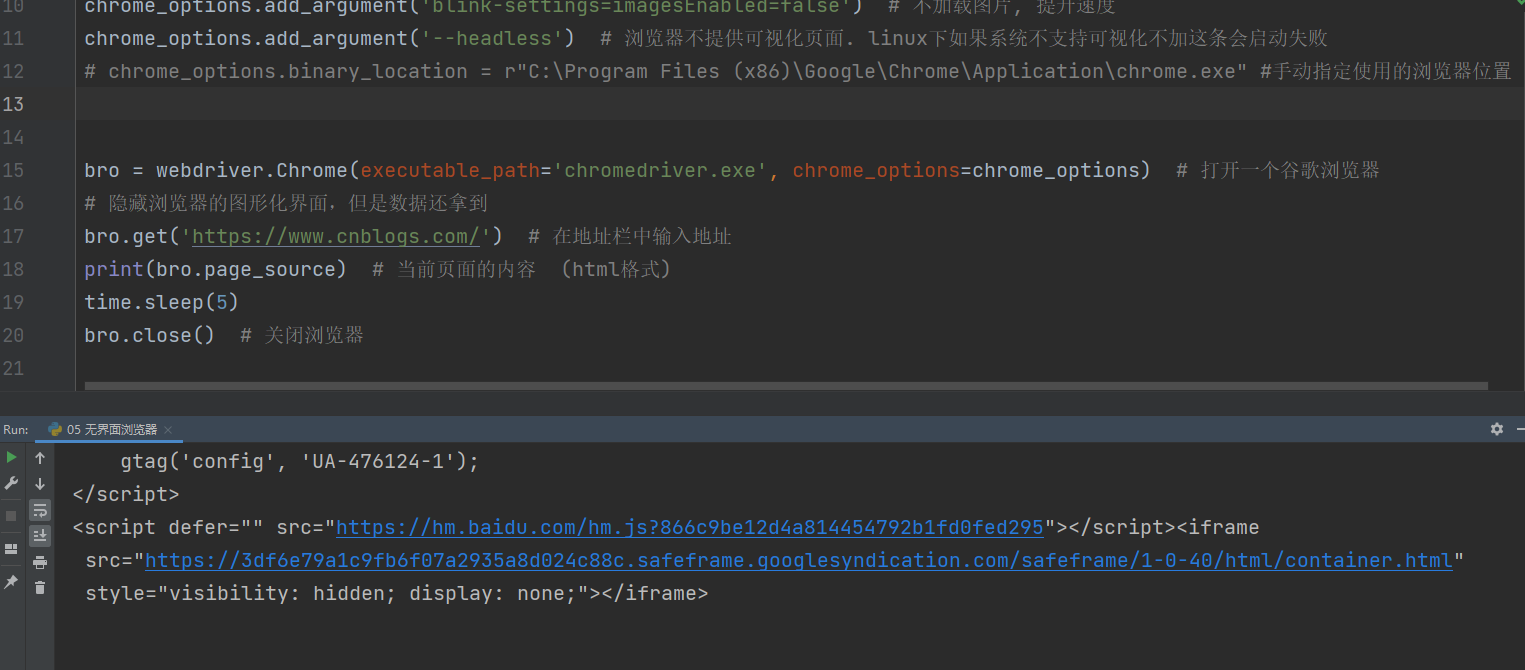昨日回顾
# 1 request 高级用法
-解析json:发http的请求,返回的数据,可能是xml格式,json格式
request.get().json()
-ssl认证
-http和https的区别
https=http+ssl/tsl
-http版本区别
0.9:底层基于tcp,每次http请求,都是建立一个tcp连接,三次握手,请求结束需要四次挥手
1.1:请求头中有个参数Keep-alive,可以保证多个http请求公用一个TCP连接
2.x:多路复用,多个请求使用通一个数据包
-代理:
-发送请求,如果使用自己的ip,可能会被封(加黑名单),需要使用代理ip,
-如果使用了代理ip,还能不能访问本地的django项目--->不能
-res = requests.post('https://www.cnblogs.com',proxies={'http':'27.79.236.66:4001'})
-高匿,透明
-http请求头:x-forword-for,user-agent,cookie,referer,content-Type
-http:
-请求协议:
请求首行:请求头地址,请求方式,http的版本
请求头:key-value
请求体
-相应协议:
响应首行:相应状态码,相应字符串描述
响应头:key-value,响应状态码,cookie
响应体
-代理池:搭建免费代理池
-开源的---》原理
爬取免费代理---》验证---》存到redis中
起了一个flask服务,监听5000,访问地址,就可以随机获取代理
-自己的django 测试使用代理
-超时
-异常
-上传文件
# 2 内网穿透
-花生壳
# 3 爬取视频网站
-请求头中的数据
-请求回来的数据,不一定能直接用
# 4 爬取新闻
-bs4:find_all,find
今日内容
-
bs4介绍,遍历文档树
-
bs4搜索文档树
-
css选择器
-
selenium基本使用
-
无界面浏览器
-
selenium其它用法
1 bs4介绍,遍历文档树
# beautifulsoup4
从HTML或XML文件中提取数据的python库
用它来解析爬取回来的xml
# 安装
pip install beautifulsoup4
pip install lxml (解析库)
# soup=BeautifulSoup('要解析的内容str类型','html.parser/lxml')
1.1 bs4的遍历文档树
from bs4 import BeautifulSoup
html_doc = """
<html><head><title>The Dormouse's story</title></head>
<body>
<p class="title">
superxz
<b>The Dormouse's story</b>
</p>
<p class="story">Once upon a time there were three little sisters; and their names were
<a href="http://example.com/elsie" class="sister" id="link1" name='superxz'>Elsie</a>
<a href="http://example.com/lacie" class="sister" id="link2">Lacie</a> and
<a href="http://example.com/tillie" class="sister" id="link3">Tillie</a>;
and they lived at the bottom of a well.</p>
<p class="story">...</p>
"""
soup = BeautifulSoup(html_doc, 'lxml')
# 1 美化,不是标准xml,完成美化
print(soup.prettify())
# 2 遍历文档树---》通过 . 来遍历
print(soup.html.body.p) # 一层一层找
print(soup.p) # 跨层 只找第一个
# 3 获取标签名称
print(soup.a.name)
# 4 获取标签属性---》属性字典
print(soup.a.attrs['href'])
print(soup.a.attrs.get('class')) # class 会有多个['class']
print(soup.a.attrs.get('name'))
# 5 获取标签的内容
# text 获取该标签内部子子孙孙所有的标签的文本内容
print(soup.p.text)
# string p下的文本只有一个时,取到,否则为None
print(soup.p.string)
# strings
print(list(soup.p.strings)) # generator 生成器
# 6 嵌套选择
print(soup.html.body)
# -----------了解
# 7 子节点,子孙节点
print(soup.body.contents) # p下所有子节点,只取一层
print(list(soup.p.children)) # list_iterator得到一个迭代器,包含p下所有子节点 只取一层
print(list(soup.body.descendants)) # generator 子子孙孙
# 8 父节点、祖先节点
print(soup.a.parent) # 获取a标签的父节点 直接父亲
print(list(soup.a.parents)) # 找到a标签所有的祖先节点,父亲的父亲,父亲的父亲的父亲...
# 9 兄弟节点
print(soup.a.next_sibling) # 下一个兄弟
print(soup.a.previous_sibling) # 上一个兄弟
print(list(soup.a.next_siblings)) # 下面的兄弟们=>生成器对象
print(list(soup.a.previous_siblings)) # 上面的兄弟们=>生成器对象
2 bs4搜索文档树
# find find_all
html_doc = """
<html><head><title>The Dormouse's story</title></head>
<body>
<p id="my p" class="title"><b id="bbb" class="boldest">The Dormouse's story</b>
</p>
<p class="story">Once upon a time there were three little sisters; and their names were
<a href="http://example.com/elsie" class="sister" id="link1">Elsie</a>,
<a href="http://example.com/lacie" class="sister" id="link2">Lacie</a> and
<a href="http://example.com/tillie" class="sister" id="link3">Tillie</a>;
and they lived at the bottom of a well.</p>
<p class="story">...</p>
"""
from bs4 import BeautifulSoup
soup = BeautifulSoup(html_doc, 'lxml')
# 五种过滤器: 字符串、正则表达式、列表、True、方法
# 1 字符串--->查询的条件是字符串
# res = soup.find_all(name='p')
res = soup.find_all('p')
print(res)
# 类名叫sister的所有标签
res = soup.find_all(class_='sister')
print(res)
# id 叫link1的标签
res = soup.find_all(id='link1')
print(res)
# 文本内容叫Elsie的父标签
res = soup.find(text='Elsie').parent
print(res)
# 另一种方式
res = soup.find_all(attrs={'class': 'sister'})
# res = soup.find_all(attrs={'id': 'link1'})
print(res)
# 2 正则表达式
import re
res = soup.find_all(id=re.compile('^l'))
# res = soup.find_all(class_=re.compile('^s'))
print(res)
# 3 列表
res = soup.find_all(id=['link1', 'link2'])
print(res)
print(soup.find_all(name=['a', 'b']))
print(soup.find_all(['a','b']))
# 4 True
res = soup.find_all(id=True) # 所有有id的标签
# res = soup.find_all(href=True)
# res = soup.find_all(class_=True)
print(res)
# 5 方法
def has_class_but_no_id(tag):
return tag.has_attr('class') and not tag.has_attr('id')
print(soup.find_all(name=has_class_but_no_id))
2.1 find的其他参数
name
class_
id
text
attrs
------------------
limit:限制调试,find_all用的 find本质是find_all limit=1
recursive:查找的时候,是只找第一层还是子子孙孙都找,默认是True,子子孙孙都找
# limit 参数
res = soup.find_all(href=True, limit=2) # 只拿两条
print(res)
# recursive 查找的时候,是只找第一层还是子子孙孙都找
res = soup.find_all(name='b', recursive=False)
# res = soup.find_all(name='b')
print(res)
# 建议遍历和搜索一起用
res = soup.html.body.p.find_all(name='b', recursive=False)
print(res)
3 css选择器
# 之前学过css选择器,可以很复杂
.类名
# id
p
# 咱们只学了bs4,以后可能见到别的解释器(lxml)--->他们都会支持css选择器,也会支持xpath
# bs4 支持css选择器
# html_doc = """
# <html><head><title>The Dormouse's story</title></head>
# <body>
# <p class="title">
# <b>The Dormouse's story</b>
# Once upon a time there were three little sisters; and their names were
# <a href="http://example.com/elsie" class="sister" id="link1">
# <span>Elsie</span>
# </a>
# <a href="http://example.com/lacie" class="sister" id="link2">Lacie</a> and
# <a href="http://example.com/tillie" class="sister" id="link3">Tillie</a>;
# <div class='panel-1'>
# <ul class='list' id='list-1'>
# <li class='element'>Foo</li>
# <li class='element'>Bar</li>
# <li class='element'>Jay</li>
# </ul>
# <ul class='list list-small' id='list-2'>
# <li class='element'><h1 class='yyyy'>Foo</h1></li>
# <li class='element xxx'>Bar</li>
# <li class='element'>Jay</li>
# </ul>
# </div>
# and they lived at the bottom of a well.
# </p>
# <p class="story">...</p>
# """
from bs4 import BeautifulSoup
# soup=BeautifulSoup(html_doc,'lxml')
# select内写css选择器
# print(soup.select('.sister'))
# print(soup.select('#link1'))
# print(soup.select('#link1 span'))
# 终极大招---》如果不会写css选择器,可以复制
import requests
res = requests.get('https://www.w3school.com.cn/css/css_selector_attribute.asp')
soup = BeautifulSoup(res.text, 'lxml')
# print(soup.select('#intro > p:nth-child(1) > strong'))
print(soup.select('#intro > p:nth-child(1) > strong')[0].text)
4 selenium介绍与基本使用
# selenium
selenium最初是一个自动化测试工具,而爬虫中使用它主要是为了解决requests无法直接执行JavaScript代码的问题
selenium本质是通过驱动浏览器,完全模拟浏览器的操作,比如跳转、输入、点击、下拉等,来拿到网页渲染之后的结果,可支持多种浏览器
4.1 基本使用
# 使用步骤:
1 下载selenium
2 操作浏览器:分不同浏览器,需要下载不同浏览器的驱动
用谷歌--->谷歌浏览器驱动:
-用谷歌---》谷歌浏览器驱动:
https://registry.npmmirror.com/binary.html?path=chromedriver/
-跟谷歌浏览器版本要对应 111.0.5563.65:
3 下载完的驱动,放在项目路径下
4 写代码 控制谷歌浏览器
from selenium import webdriver
import time
bro = webdriver.Chrome(executable_path='chromedriver.exe') # 打开一个谷歌浏览器
bro.get('https://www.douyin.com/') # 在地址栏中输入地址
print(bro.page_source) # 当前页面的内容 (html)
with open('1.html', 'w', encoding='utf-8')as f:
f.write(bro.page_source)
time.sleep(5)
bro.close() # 关闭浏览器
5 无界面浏览器
from selenium import webdriver
import time
from selenium.webdriver.chrome.options import Options
# 隐藏浏览器的图形化界面,但是数据还拿到
chrome_options = Options()
chrome_options.add_argument('window-size=1920x3000') # 指定浏览器分辨率
chrome_options.add_argument('--hide-scrollbars') # 隐藏滚动条, 应对一些特殊页面
chrome_options.add_argument('blink-settings=imagesEnabled=false') # 不加载图片, 提升速度
chrome_options.add_argument('--headless') # 浏览器不提供可视化页面. linux下如果系统不支持可视化不加这条会启动失败
# chrome_options.binary_location = r"C:\Program Files (x86)\Google\Chrome\Application\chrome.exe" #手动指定使用的浏览器位置
bro = webdriver.Chrome(executable_path='chromedriver.exe', chrome_options=chrome_options) # 打开一个谷歌浏览器
# 隐藏浏览器的图形化界面,但是数据还拿到
bro.get('https://www.cnblogs.com/') # 在地址栏中输入地址
print(bro.page_source) # 当前页面的内容 (html格式)
time.sleep(5)
bro.close() # 关闭浏览器

5.1 模拟登录百度
from selenium import webdriver
import time
from selenium.webdriver.common.by import By
bro = webdriver.Chrome(executable_path='chromedriver.exe') # 打开一个谷歌浏览器
bro.get('https://www.baidu.com')
# 加入等待:找标签,如果找不到,就等待 x秒,如果还找不到就报错
bro.implicitly_wait(10) # 1 等待
# 从页面中找到登录 a标签,点击它
# By.LINK_TEXT 按a标签文本内容找
btn = bro.find_element(by=By.LINK_TEXT, value='登录')
# 点击它
btn.click()
# 找到按账号登录的点击按钮,有id,优先用id,因为唯一 TANGRAM__PSP_11__changePwdCodeItem
btn_2 = bro.find_element(by=By.ID, value='TANGRAM__PSP_11__changeSmsCodeItem')
btn_2.click()
time.sleep(1)
btn_2 = bro.find_element(by=By.ID, value='TANGRAM__PSP_11__changePwdCodeItem')
btn_2.click()
time.sleep(1)
name = bro.find_element(by=By.ID, value='TANGRAM__PSP_11__userName')
password = bro.find_element(by=By.ID, value='TANGRAM__PSP_11__password')
name.send_keys('123456789@qq.com')
password.send_keys('1234')
time.sleep(1)
submit = bro.find_element(by=By.ID, value='TANGRAM__PSP_11__submit')
submit.click()
time.sleep(2)
bro.close() # 关闭浏览器
6 selenium其它用法
6.1 查找标签
# 两个方法
bro.find_element 找一个
bro.find_elements 找所有
# 可以按id,标签名,name属性名,类名,a标签的文字,a标签的文字模糊匹配,css选择器,xpath【后面聊】
input_1=bro.find_element(by=By.ID,value='kw') # 按id找
input_1 = bro.find_element(by=By.NAME, value='wd') # name属性名
input_1=bro.find_element(by=By.TAG_NAME,value='input') # 可以按标签名字找
input_1=bro.find_element(by=By.CLASS_NAME,value='s_ipt') # 可以按类名
input_1=bro.find_element(by=By.LINK_TEXT,value='登录') # 可以按a标签内容找
input_1=bro.find_element(by=By.PARTIAL_LINK_TEXT,value='录') # 可以按a标签内容找
input_1 = bro.find_element(by=By.CSS_SELECTOR, value='#su') # 可以按css选择器
6.2 获取位置属性大小,文本
print(tag.get_attribute('src')) # 用的最多 拿标签的属性
tag.text # 文本内容
#获取标签ID,位置,名称,大小(了解)
print(tag.id)
print(tag.location)
print(tag.tag_name)
print(tag.size)
6.3 等待元素被加载
# 代码执行很快,有的标签没来的及加载,直接查找就会报错,设置等待
# 隐士等待:所有标签,只要去找,找不到就遵循 等10s的规则
bro.implicitly_wait(10)
# 显示等待:需要给每个标签绑定一个等待,麻烦
6.4 元素操作
# 点击
tag.click()
# 输入内容
tag.send_keys()
# 清空内容
tag.clear()
# 浏览器对象 最大化
bor.maximize_window()
# 浏览器对象 截全屏
bro.save_screenshot()
6.5 执行js代码
bro.execute_script('alert("美女")') # 引号内部的相当于 用script标签包裹了
# 可以干的事
-获取当前访问的地址 window.location
-打开新的标签
-滑动屏幕--->
bro.execute_script('scrollTo(0,document.documentElement.scrollHeight)')
-获取cookie,获取定义的全局变量
6.6 切换选项卡
import time
from selenium import webdriver
browser=webdriver.Chrome(executable_path='chromedriver.exe')
browser.get('https://www.baidu.com')
browser.execute_script('window.open()')
print(browser.window_handles) #获取所有的选项卡
browser.switch_to.window(browser.window_handles[1])
browser.get('https://www.taobao.com')
time.sleep(2)
browser.switch_to.window(browser.window_handles[0])
browser.get('https://www.sina.com.cn')
browser.close()
6.7 浏览器前进后退
import time
from selenium import webdriver
browser=webdriver.Chrome(executable_path='chromedriver.exe')
browser.get('https://www.baidu.com')
browser.get('https://www.taobao.com')
browser.get('http://www.sina.com.cn/')
browser.back()
time.sleep(2)
browser.forward()
browser.close()
5.7 异常处理
import time
from selenium import webdriver
browser=webdriver.Chrome(executable_path='chromedriver.exe')
try:
except Exception as e:
print(e)
finally:
browser.close()
